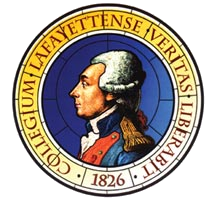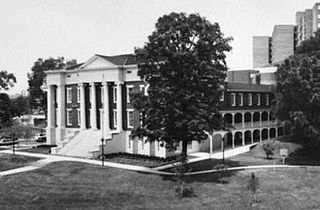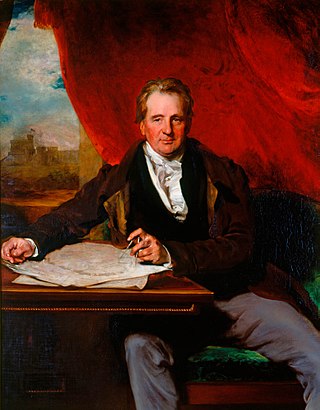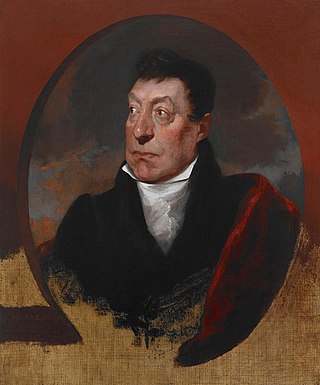
Thomas Hopkins Gallaudet was an American educator. Along with Laurent Clerc and Mason Cogswell, he co-founded the first permanent institution for the education of the deaf in North America, and he became its first principal. When opened on April 15, 1817, it was called the "Connecticut Asylum for the Education and Instruction of Deaf and Dumb Persons," but it is now known as the American School for the Deaf.

Egyptian Revival is an architectural style that uses the motifs and imagery of ancient Egypt. It is attributed generally to the public awareness of ancient Egyptian monuments generated by Napoleon's conquest of Egypt and Admiral Nelson's defeat of the French Navy at the Battle of the Nile in 1798. Napoleon took a scientific expedition with him to Egypt. Publication of the expedition's work, the Description de l'Égypte, began in 1809 and was published as a series through 1826. The size and monumentality of the façades discovered during his adventure cemented the hold of Egyptian aesthetics on the Parisian elite. However, works of art and architecture in the Egyptian style had been made or built occasionally on the European continent since the time of the Renaissance.

Augustus Seymour Porter was a U.S. statesman from the state of Michigan.

Lafayette College is a private liberal arts college in Easton, Pennsylvania. Founded in 1826 by James Madison Porter and other citizens in Easton, the college first held classes in 1832. The founders voted to name the college after General Lafayette, a hero of the American Revolution.

John Haviland was an English-born American architect who was a major figure in American Neo-Classical architecture, and one of the most notable architects working from Philadelphia during the nineteenth century.

Old City Hall is a complex of historic buildings located at 601 West Summit Hill Drive in Knoxville, Tennessee, United States. Originally constructed in 1848 as the Tennessee School for the Deaf and Dumb, the complex served as Knoxville's city hall from 1925 until 1980. The complex has been listed on the National Register of Historic Places and has been documented by the Historic American Buildings Survey. It currently houses Lincoln Memorial University's Duncan School of Law.
Port Pegasus, officially Port Pegasus / Pikihatiti, is at the southern end of Stewart Island in New Zealand. From the 1890s to the 1950s, Port Pegasus was the site of a small fishing community. There was also a small tin-mining boom in the area in the 1890s. Today, there is no settlement at Port Pegasus, but the location is frequented by tourists, fishermen, hunters, and divers.

Francis Maginn (1861–1918) was a Church of Ireland missionary who worked to improve living standards for the deaf community by promoting sign language and was one of the co-founders of the British Deaf Association.

Georges Washington Louis Gilbert de La Fayette was the son of Gilbert du Motier, Marquis de Lafayette, the French officer and hero of the American Revolution, and Adrienne de La Fayette. He was named in honor of George Washington, under whom his father served in the Revolutionary War.

From July 1824 to September 1825, the French Marquis de Lafayette, the last surviving major general of the American Revolutionary War, made a tour of the 24 states in the United States. He was received by the populace with a hero's welcome at many stops, and many honors and monuments were presented to commemorate and memorialize the visit.

William Leete Stone, known as Colonel Stone, was an influential journalist, publisher, author, and public official in New York City. His name also appears as "Leet".

Sir Jeffry Wyatville was an English architect and garden designer. Born Jeffry Wyatt into an established dynasty of architects, in 1824 he was allowed by King George IV to change his surname to Wyatville. He is mainly remembered for making alterations and extensions to Chatsworth House and Windsor Castle.
The New York School for the Deaf is a private school for the deaf in Greenburgh, New York, in Westchester County just north of New York City, United States. It is private non-profit tax-exempt organization under article 501(c)(3) of U.S. law.

The Lafayette Welcoming Parade of 1824 was a parade held in New York City on August 16, 1824, to welcome the arrival of the Marquis de Lafayette on the occasion of his visit to the United States for a sixteen-month tour. It has been described as the first triumphal parade in New York history.

The Lafayette Welcoming Parade of 1824 was a parade held in Philadelphia in September 1824 to welcome the arrival of the Marquis de Lafayette on the occasion of his visit to the United States for a sixteen-month tour.

Marquis de Lafayette was painted in 1825 by Samuel Morse. Mostly known for his creation of the electric telegraph, Morse was also an artist. Morse was a Professor of Painting and Sculpture at the University of the City of New York.
Levi Strong Backus (1803–1868) is widely considered the first deaf editor of America, if not the world. He ran a newspaper called the Radii.
Reuben Haines III was a Quaker farmer, brewer, abolitionist, scientist, ornithologist, meteorologist, firefighter, philanthropist, and educational reformer from Philadelphia, Pennsylvania.
John Gerard Coster was a Dutch-American merchant who served as president of the Bank of the Manhattan Company.

Samuel Akerly was an American physician, superintendent of the New York Institution for the Deaf from 1821 to 1831, and co-founder and president of the New York Institute for the Education of the Blind from 1831 to 1842.
















